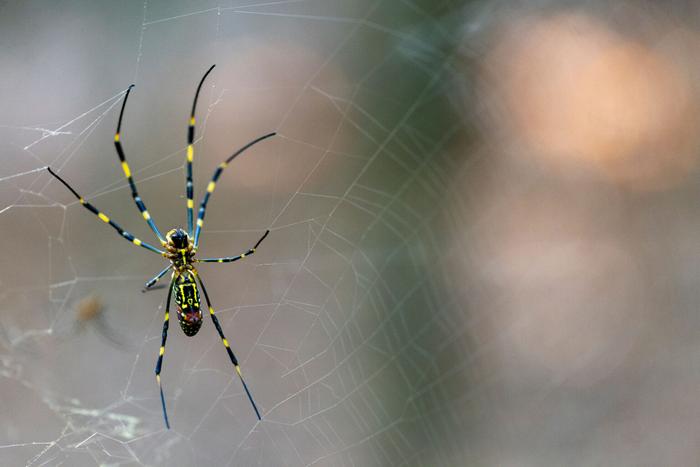The Jorō (Joro) spider was first spotted stateside around 2013 and has since been spotted across Georgia and the Southeast. New research from the University of Georgia has found more clues as to why the spider has been so successful in its spread.

Credit: (Photo by UGA/Dorothy Kozlowski)
The Jorō (Joro) spider was first spotted stateside around 2013 and has since been spotted across Georgia and the Southeast. New research from the University of Georgia has found more clues as to why the spider has been so successful in its spread.
The study found the invasive orb-weaving spider is surprisingly tolerant of the vibrations and noise common in urban landscapes.
In this new study, researchers examined how Joro spiders can live next to busy roads, which are notably stressful environments for many animals.
The researchers found that while Joro spiders near busier roads are somewhat less likely to attack simulated prey, the spiders don’t seem to be hurting for it and clock in at about the same weight as their counterparts in less busy locations. That suggests the species can successfully compensate for its human-dominated landscape.
“If you’re a spider, you rely on vibrations to do your job and catch bugs,” said Andy Davis, corresponding author of the study and a research scientist in UGA’s Odum School of Ecology. “But these Joro webs are everywhere in the fall, including right next to busy roads, and the spiders seem to be able to make a living there. For some reason, these spiders seem urban tolerant.”
Busy roads don’t affect Joro spider health, weight
Joro spiders are regularly spotted in areas that native Georgia spiders don’t inhabit.
They build their golden webs between powerlines, on top of stoplights and even above the pumps at local gas stations—none of which are particularly peaceful spots.
This is what drew Davis and his team to study their behavior near roadsides.
Davis and a team of undergraduates from the Odum School used a tuning fork to simulate the vibrations caused by prey when caught in a spider’s web and then watched if the spiders attacked. Of the more than 350 trials, Joro spiders attacked the simulated prey 59% of the time.
The spiders in webs near busy roads attacked about half the time while those near lower traffic areas pounced 65% of the time.
Despite that slight difference, it doesn’t look like it’s affecting the spiders’ body mass or health.
“It looks like Joro spiders are not going to shy away from building a web under a stoplight or an area where you wouldn’t imagine a spider to be,” said Alexa Schultz, co-author of the study and a third-year ecology student at UGA. “I don’t know how happy people are going to be about it, but I think the spiders are here to stay.” Her undergraduate co-authors, Kade Stewart and Caitlin Phelan, agreed.
Joro spiders likely to spread beyond Southeast
In their native Japan, the East Asian Joro spider colonizes most of the country. Japan also has a very similar climate to the U.S. and is approximately the same latitude.
The present study builds on previous work from Davis’ lab that showed Joro spiders are well equipped to spread through most of the Eastern Seaboard due to their high metabolism and heart rate. The spiders are also cold tolerant, surviving brief freezes that kill off many of their orb-weaving cousins.
Their hardiness is one trait that’s enabled the spiders to explode in population stateside, with numbers easily in the millions now. The new research suggests that the Joros’ tolerance of urban vibrations and sounds is likely another factor in the species’ exponential growth.
But their spread shouldn’t be too alarming, the researchers said. The spiders are rather timid.
Published by Arthropoda, the study is available here.
Journal
Arthropoda
DOI
10.3390/arthropoda2010004
Article Title
How Urban-Tolerant Are They? Testing Prey–Capture Behavior of Introduced Jorō Spiders (Trichonephila clavata) Next to Busy Roads
Article Publication Date
13-Feb-2024




